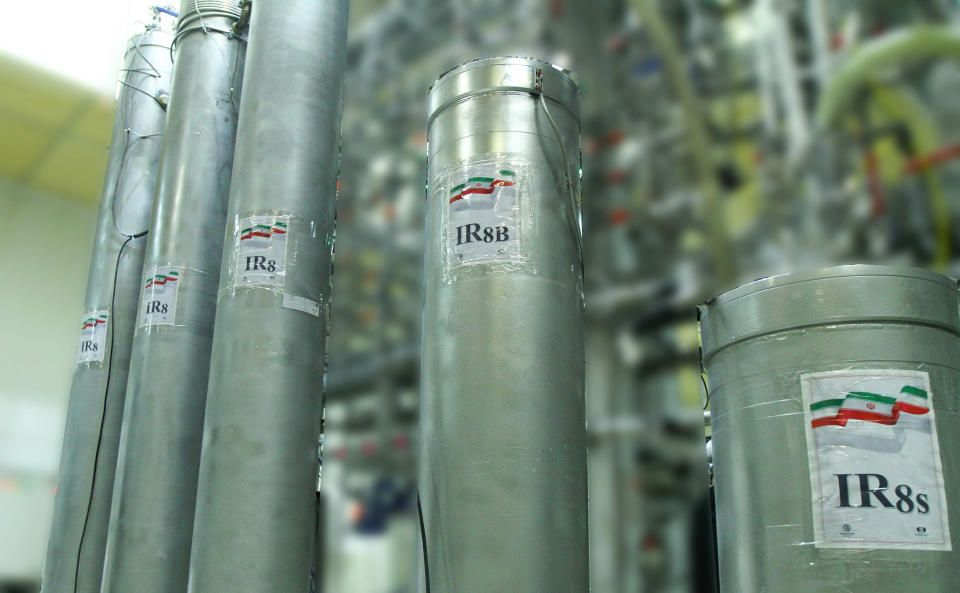Mystery surrounds fire at Iranian nuclear site
A fire last week at the Natanz nuclear site, Iran’s main uranium enrichment facility, caused “significant” damage, the country's nuclear agency said, lifting part of the mystery surrounding the event.
It still remains unclear, however, exactly what happened at the site in central Isfahan province. Iranian authorities at first appeared to downplay it, saying only that a fire had broken out early Thursday at an “industrial shed.”
But Behrouz Kamalvandi, a spokesman for the Atomic Energy Organization of Iran, told Iran's official IRNA news agency in an interview Sunday that the fire “caused significant financial damage but there were no casualties."
Specifically, a building that produces advanced centrifuges, used in the enrichment of uranium, was damaged. Measuring equipment and instruments were also destroyed, Kamalvandi said.
“In the midterm this can lead to a slow down in the organization's task, but we will put all our efforts to overcome this interruption,” he told IRNA, adding that Iran would rebuild the damaged building on a bigger plot of land.
The region remains on edge more than six months after a U.S. drone strike killed a top Iranian general in Baghdad in January, and Tehran launched a retaliatory attack on American forces in Iraq in an escalation of tensions that threatened to tip the region into war.
The Natanz fire came after reports of an explosion late last month near a missile facility outside Parchin, southeast of Tehran. Iranian authorities said the blast was caused by a gas tank explosion in a military complex.
On Saturday, another fire broke out at a power plant in the southwest. The incidents have prompted rumors of state-sponsored sabotage to spread.

Kamalvandi said Sunday that the Iranian security bodies know the cause of the incident but do not intend to comment because of security precautions.
The series of events at the Iranian sites prompted speculation that Israel, as well as Saudi Arabia and the United States, could be behind the incidents.
Asked Thursday about the incident in Natanz, Israeli Prime Minister Benjamin Netanyahu said, "Clearly, we can't get into that."
Israel is widely believed to be the region's only nuclear power and has vowed never to allow Tehran to obtain atomic weapons. Many Israelis believe Iran poses an existential threat to the world's only Jewish state.
Last month, according to Reuters, Zeev Elkin, an Israeli security cabinet minister, said Iran had tried to mount a cyberattack on Israel's water system in April.
An Iranian official at the country's mission to the U.N. denied Tehran had any involvement in the attack, saying "Iran does not take part in any cyberwar," the semi-official Mehr news agency reported.
The latest back-and-forth comes as Israel launched a reconnaissance satellite into space Monday.
“We are not letting up for a moment in our efforts on the security issue," said Netanyahu. "The success of the Ofek 16 satellite very much increases our ability to act against Israel’s enemies, near and far alike."
In 2010, the Stuxnet computer virus, widely believed to have been developed by the United States and Israel, was discovered after it was used to attack Natanz.
Natanz is monitored by inspectors of the International Atomic Energy Agency, the U.N. nuclear watchdog. Iran has consistently denied seeking nuclear arms and maintains its nuclear program is for peaceful purposes.
A state department spokesperson said it was "monitoring reports" of a fire at an Iranian nuclear facility.
"This incident serves as another reminder of how the Iranian regime continues to prioritize its misguided nuclear program to the detriment of the Iranian people's needs," the spokesperson said.
Secretary of State Mike Pompeo told the U.N. Security Council last Tuesday that Iran was developing a new centrifuge that would be able to enrich uranium up to 50 times faster than it currently can.
Iran, he said, was “showing no signs of slowing its destabilizing nuclear escalation” and was accumulating “dangerous” knowledge.
Kamalvandi said Sunday that work had begun on the complex to produce advanced centrifuges at the Natanz site in 2013, but that construction had stopped because of the 2015 Iran nuclear deal.
The 2015 deal eased U.S. and United Nations sanctions on Iran in return for limits on its nuclear program. In May 2018, Trump withdrew the United States from the agreement and imposed a wave of economic sanctions on the country's oil and banking industries and other key sectors.
Kamalvandi said the complex was inaugurated a month after the U.S. pulled out of the deal, but had not been operating at full capacity because of restrictions imposed by the agreement. Iran is still party to the deal along with the United Kingdom, France, China, Russia and Germany.
Reuters and The Associated Press contributed to this report.

